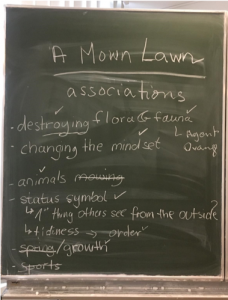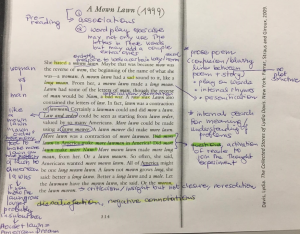Thursday, Jan. 23, 2020 (10:47 a.m.)
Lydia Davis (1947- ) is a lover of language and an American writer, probably in that order. She’s best known for her minimalist writing style and works of brevity (short stories, flash fiction, and narratives made up of only a couple of lines). One of my favorite prose poems is “A Mown Lawn.” It is literally one-of‑a kind. Well, almost. I think Davis wrote two political pieces, of which “A Mown Lawn” is one. If you aren’t familiar with it, please read it, otherwise this blog might not make sense (see image below).
As some of our loyal readers might recall, my colleague Maria Moss has written several blogs on how to teach poetry, including “Stopping by Woods on a Snowy Evening” by Robert Frost and Haikus. But I’m not like her. To be honest, I’m somewhat leery of the long faces students often make when they hear the word ‘poetry.’ Determined to give it a try, I prepared a lesson that would hopefully help my students appreciate Davis’s poem, engage with the topics, and think about language – the power of language, or should I say, the lack thereof? Anyway, here are my notes:
12:10 p.m.
Off to class. Let’s see how it goes.
2:00 p.m. 
I must say my students did quite well. All but one enjoyed the poem, and there were actually no long sighs. Without giving any guiding questions, I asked them to decipher the poem in groups. After about 25 minutes, the class was able to connect almost all their pre-reading associations in some way to the poem. Not bad. Not bad at all.
Perhaps the next time I teach the poem, I would ask my students to see if they could find their own metaphor for some aspect of society that they would like to criticize. So yes, I guess there will be a next time. Maybe Maria is rubbing off on me, and the changing mindset my students referred to (see the picture on the right) also applies to my view on teaching poetry. And maybe, just maybe, you might give poetry a try, too?
26,108 Total Views, 2 Views Today







